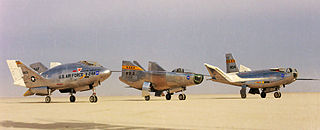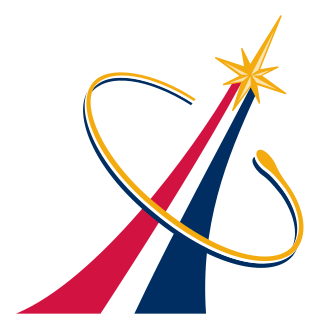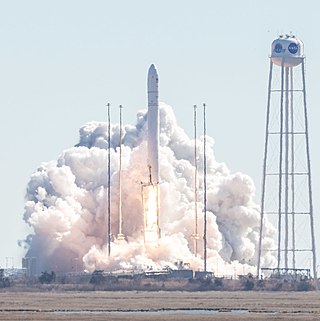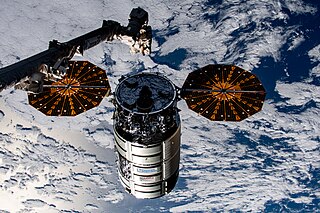
A lifting body is a fixed-wing aircraft or spacecraft configuration in which the body itself produces lift. In contrast to a flying wing, which is a wing with minimal or no conventional fuselage, a lifting body can be thought of as a fuselage with little or no conventional wing. Whereas a flying wing seeks to maximize cruise efficiency at subsonic speeds by eliminating non-lifting surfaces, lifting bodies generally minimize the drag and structure of a wing for subsonic, supersonic and hypersonic flight, or spacecraft re-entry. All of these flight regimes pose challenges for proper flight safety.

A spaceplane is a vehicle that can fly and glide like an aircraft in Earth's atmosphere and maneuver like a spacecraft in outer space. To do so, spaceplanes must incorporate features of both aircraft and spacecraft. Orbital spaceplanes tend to be more similar to conventional spacecraft, while sub-orbital spaceplanes tend to be more similar to fixed-wing aircraft. All spaceplanes to date have been rocket-powered for takeoff and climb, but have then landed as unpowered gliders.

Dream Chaser is an American reusable lifting-body spaceplane developed by Sierra Space. Originally intended as a crewed vehicle, the Dream Chaser Space System is set to be produced after the Dream Chaser Cargo System cargo variant is operational. The crewed variant is planned to carry up to seven people and cargo to and from low Earth orbit.

The HL-20 Personnel Launch System was a NASA spaceplane concept for crewed orbital missions studied by NASA's Langley Research Center around 1990. It was envisaged as a lifting body re-entry vehicle similar to the Soviet BOR-4 spaceplane design. Its stated goals were to achieve low operational costs, improved flight safety, and a possibility of landing on conventional runways. No flight hardware was built.

Cygnus is an expendable American cargo spacecraft developed by Orbital Sciences Corporation but manufactured and launched by Northrop Grumman Space Systems as part of NASA's Commercial Resupply Services (CRS) program. It is usually launched by Northrop Grumman's Antares rocket from the Wallops Flight Facility, although three flights were on ULA's Atlas V and three are planned for SpaceX's Falcon 9, in both cases launching from Cape Canaveral Space Force Station. It transports supplies to the International Space Station (ISS) following the retirement of the American Space Shuttle. Since August 2000, ISS resupply missions have been regularly flown by the Russian Progress spacecraft, as well as by the European Automated Transfer Vehicle, and the Japanese H-II Transfer Vehicle. With the Cygnus spacecraft and the SpaceX Dragon, NASA seeks to increase its partnerships with domestic commercial aviation and aeronautics industry.
Sierra Nevada Corporation is an American aerospace, defense, electronics, engineering and manufacturing corporation that specializes in aircraft modification, integration and other space technologies. The corporation contracts with the United States Armed Forces, NASA, and private spaceflight companies. The corporation is headquartered in Sparks, Nevada, and has 36 locations in the United States, United Kingdom, Germany, and Turkey.

Commercial Resupply Services (CRS) are a series of flights awarded by NASA for the delivery of cargo and supplies to the International Space Station (ISS) on commercially operated spacecraft. The first CRS contracts were signed in 2008 and awarded $1.6 billion to SpaceX for twelve cargo Dragon and $1.9 billion to Orbital Sciences for eight Cygnus flights, covering deliveries to 2016. The Falcon 9 and Antares rockets were also developed under the CRS program to deliver cargo spacecraft to the ISS.

Prometheus was a proposed crewed vertical-takeoff, horizontal-landing (VTHL) lifting body spaceplane concept put forward by Orbital Sciences Corporation in late 2010 as part of the second phase of NASA's Commercial Crew Development (CCDev) program.

A number of different spacecraft have been used to carry cargo to and from space stations.

OA-9E was the tenth flight of the Orbital ATK uncrewed resupply spacecraft Cygnus and its ninth flight to the International Space Station (ISS) under the Commercial Resupply Services with NASA. The mission launched on 21 May 2018 at 08:44:06 UTC. Orbital ATK and NASA jointly developed a new space transportation system to provide commercial cargo resupply services to the International Space Station. Under the Commercial Orbital Transportation Services (COTS) program, then Orbital Sciences designed and built Antares, a medium-class launch vehicle; Cygnus, an advanced maneuvering spacecraft, and a Pressurized Cargo Module which is provided by Orbital's industrial partner Thales Alenia Space.

NG-10, previously known as OA-10E, is the eleventh flight of the Northrop Grumman uncrewed resupply spacecraft Cygnus and its tenth flight to the International Space Station under the Commercial Resupply Services (CRS-1) contract with NASA. The mission launched on 17 November 2018, at 09:01:31 UTC. This particular mission is part of an extension of the initial CRS contract that enables NASA to cover the ISS resupply needs until the Commercial Resupply Services-2 (CRS-2) contract enters in effect.

The HL-42 was a proposed scaled-up version of the HL-20 re-usable crewed spaceplane design, which had been developed from 1983 to 1991 at NASA's Langley Research Center but never flown. Like the HL-20, the HL-42 would have been launched into low Earth orbit mounted on top of a two-stage expendable rocket. At the end of the mission it would have re-entered and glided to a runway landing.

Dragon, also known as Dragon 1 or Cargo Dragon, was a class of fourteen partially reusable cargo spacecraft developed by SpaceX, an American private space transportation company. The spacecraft flew 23 missions between 2010 and 2020. Dragon was launched into orbit by the company's Falcon 9 launch vehicle to resupply the International Space Station (ISS).

NG-13, previously known as OA-13, was the fourteenth flight of the Northrop Grumman robotic resupply spacecraft Cygnus and its thirteenth flight to the International Space Station (ISS) under the Commercial Resupply Services (CRS-1) contract with NASA. The mission launched on 15 February 2020 at 20:21:01 UTC after nearly a week of delays. This is the second launch of Cygnus under the CRS-2 contract.

NG-15, previously known as OA-15, was the fifteenth launch of the Northrop Grumman robotic resupply spacecraft Cygnus and its fourteenth flight to the International Space Station (ISS) under the Commercial Resupply Services (CRS) contract with NASA. The mission launched on 20 February 2021 at 17:36:50 UTC. This is the fourth launch of Cygnus under the CRS-2 contract.

The Commercial Crew Program (CCP) provides commercially operated crew transportation service to and from the International Space Station (ISS) under contract to NASA, conducting crew rotations between the expeditions of the International Space Station program. American space manufacturer SpaceX began providing service in 2020, using the Crew Dragon spacecraft, and NASA plans to add Boeing when its Boeing Starliner spacecraft becomes operational no earlier than 2025. NASA has contracted for six operational missions from Boeing and fourteen from SpaceX, ensuring sufficient support for ISS through 2030.

Cygnus NG-17, previously known as Cygnus OA-17, was the seventeenth flight of the Northrop Grumman robotic resupply spacecraft Cygnus and its sixteenth flight to the International Space Station (ISS) under the Commercial Resupply Services (CRS) contract with NASA. The mission launched on 19 February 2022 at 17:40:03 UTC. It was the sixth launch of Cygnus under the CRS-2 contract.

NG-18 was the eighteenth flight of the Northrop Grumman robotic resupply spacecraft Cygnus and its seventeenth flight to the International Space Station (ISS) under the Commercial Resupply Services (CRS-2) contract with NASA. The mission successfully launched on 7 November 2022 at 10:32:42 UTC. This was the seventh launch of Cygnus under the CRS-2 contract.

NG-19 was the nineteenth flight of the Northrop Grumman robotic resupply spacecraft Cygnus and its eighteenth flight to the International Space Station (ISS) under the Commercial Resupply Services (CRS-2) contract with NASA. The mission launched on 2 August 2023 at 00:31:14 UTC. This was the eighth launch of Cygnus under the CRS-2 contract.

Dream Chaser Tenacity (DC101) is the first Dream Chaser spacecraft expected to fly in space. Manufactured by the Sierra Nevada Corporation, it will first fly to the International Space Station as part of the SNC Demo-1 mission in 2024, under the CRS-2 contract.




















